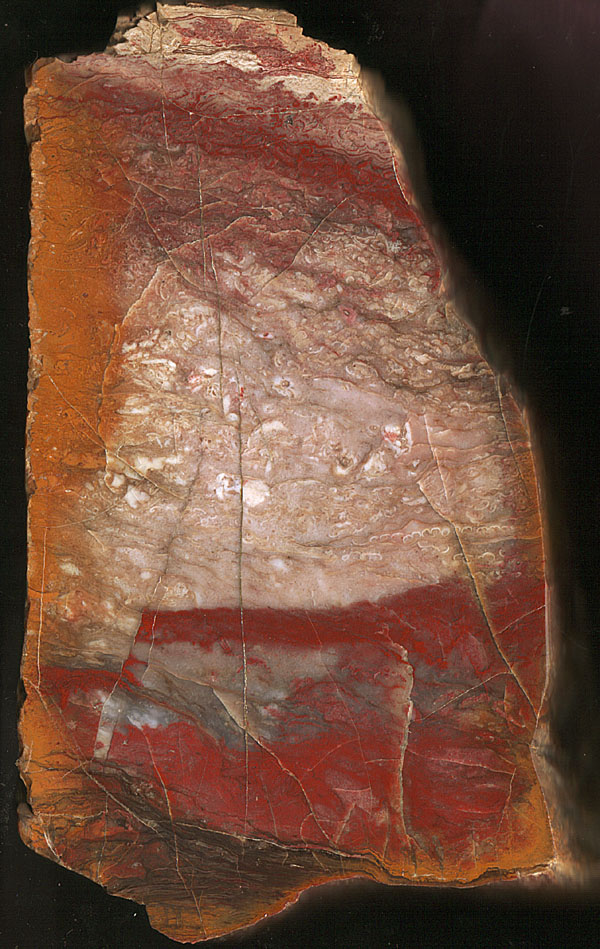Maggot stone
black-red-yellow
 Chert
with abundant enclosed fern pinnules from the Lower Permian of the
Döhlen Basin is known as "maggot stone". A specimen of this type,
distinguished by conspicuous colours, is shown here.
Chert
with abundant enclosed fern pinnules from the Lower Permian of the
Döhlen Basin is known as "maggot stone". A specimen of this type,
distinguished by conspicuous colours, is shown here.
The black
aspect in Fig.1 at the bottom is the primary one with carbon from the
decayed organic substance of gyttja. Above, the carbon had vanished by
oxidation so that the substance had become light-coloured. Iron
compounds entering into some strata by diffusion became oxidized into red
hematite. This occurred after
the siliceous substance had become solid chalzedony, which can be
inferred from cracks acting as diffusion barriers. Tiny amounts of
hematite in chalzedony can make a conspicuous effect.
The
left edge of the sample is obviously part of a nearly plane crack face
across the stiff chert layer. Probably, displacements within the sediment strata caused the brittle
layer to fragment already in the Permian.
Dissolved iron came along the crack,
entered up to 2cm into the chalzedony,
and became oxidized there into yellow Goethite.
A thin layer (up to 2mm) at the very edge became bleached later.
The chert layer fragments got pried loose from the Permian strata by
the proceeding Cretaceous sea and became
part of the boulders on the beach. Together with the sand they turned
into Cretaceous sandstone.
Later, weathering broke down the sandstone,
leaving the heavy chert boulders on the spot.
Glacial rivers moved and deposited them across the then softly
undulating area. This sample has still kept its Cretaceous surface, as
seen from tiny remains of sandstone sticking to it.
Fig.1: Old fragment of a chert layer: silicified
mud,
coloured as a result of diffusion and oxidation, with pinnules of the
tree fern Scolecopteris.
Sample (2001): Bu7/184, Part 2,
Height 18cm; Freital, Kohlenstraße.
The fern pinnules as the smallest parts of the
big fronds are well
seen as a row of cross-sections, as in Fig.1 below the middle on the
right, and in Fig.2.
Less clear are the
aggregations of randomly oriented pinnules, as in Fig.3 with sporangia,
here in groups of mainly 4 on a common stalk.
The pinnules
lacking sporangia in Fig.2 have got hairs below the midrib.
In
the middle of Fig.2, the bulging end of an apparently shorter pinnule
is tangentially cut so that lateral veins are dimly seen.

Fig.2,3 (left): Pinnules without and with sporangia.
Image widths 17mm.
The aspect of the silicified pinnules in
other samples had been misinterpreted as insects more than once, hence
the name "maggot stones". Accordingly, this tree fern got the popular
name "maggot fern", which became translated into the scientific name Scolecopteris
[1].

Fig.4 (right): Pinnules cut lengthwise; enigmatic cylindrical
fragments.
Image width 8.5mm.
Width (2mm in Fig.2) and
length (4.5mm in Fig.4) of
the pinnules fit to the
most abundant variety of the maggot fern in the Döhlen
Basin. Incidentally, the
extant fern Athyrium
growing in the present Döhlen
Basin has got pinnules of
similar size but is not even distantly related
to Scolecopteris.
Enigmatic are
cylindrical fragments, 0.05-0.3mm
wide, in this sample abundant in some places, partially not stained
for unknown reasons and thus clearly seen in
Fig.4. They are to be the
subject of another contribution.
H.-J.
Weiss
2018
[1] E.
Zenker:
Scolecopteris elegans,
ein neues fossiles Farrngewächs mit
Fructification. Linnaea 11(1837), 509-12.
|
 |
 22 22 |

 22
22 Chert
with abundant enclosed fern pinnules from the Lower Permian of the
Döhlen Basin is known as "maggot stone". A specimen of this type,
distinguished by conspicuous colours, is shown here.
Chert
with abundant enclosed fern pinnules from the Lower Permian of the
Döhlen Basin is known as "maggot stone". A specimen of this type,
distinguished by conspicuous colours, is shown here. 



 22
22